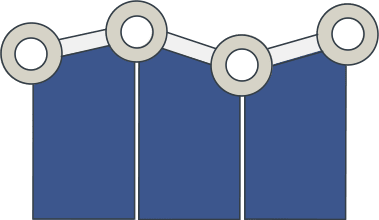Facebook allows third-party measurement and commits to an audit by the Media Rating Council
Facebook has been under fire since the revelations last year that it had been mistakenly inflating the view counts/durations on its videos. This may have influenced how brands spent marketing budgets, but the metrics were just plain wrong. As we saw in my chart of the day yesterday Facebook had been wrongly overstating views by as much as 80% .
In response to this and other revelations of widespread ad fraud in the online advertising industry, P&G's Chief Brand Officer announced a series of demands to online ad providers, which they would have to comply with or else P&G would spend its seven billion dollar ad budget elsewhere. The demands were as follows:
- Adopting one viewability standard – P&G will be accepting the Media Ratings Council (MRC) - validated viewability standard, and expect all its agencies, media suppliers and suppliers to do the same.
- Implementing accredited third-party measurement verification – P&G will be adopting MRC-accredited third-party verification during 2017, and expects every media supplier including publishers and measurement vendors to the same.
- Getting transparent agency contracts – This will include terms requiring funds to be used for media payment only, all rebates to be disclosed and returned, and all transactions subject to audit.
Whilst smaller providers can't afford to turn down P&G's ad spend, we thought that Facebook's huge size might give it a degree of immunity from these demands. However, to our surprise, Facebook has quickly announced that it will be accepting the MRC's viewability standard, allow third party verification and committed to an audit by the MRC.
 Facebook have also announced they will now be providing video view data that covers:
Facebook have also announced they will now be providing video view data that covers:
- Milliseconds that an ad was on the screen
- Milliseconds that 50% of the ad was on the screen
- Milliseconds that 100% of the ad was on the screen
This gives advertisers more power to evaluate their ad's performance across more metrics than previously.
New Facebook Ad products
Facebook said they are working on new video ad products which will give advertisers new options depending on the objectives of their campaign. The news options are as follows:
- Completed-view buying: advertisers will only pay for video ads that have been viewed in their entirety, for any duration up to 10 seconds
- Two-second buying: compliant with the MRC video standard, where at least 50% of an ad’s pixels are in-view for two continuous seconds or longer
- Sound-on buying: advertisers will have the ability to buy sound-on video ads
This is great news for advertisers, who now have more options and will be better able tailor the video ad types to the objectives of their campaigns. For example, a B2C company with mass produced products and broad audience may want to build their brand equity and reach large numbers of consumers cheaply with two-second ad buying. Whereas as B2B with a more complex purchase journey and a high lead value may want to invest in higher cost completed-view buys to a smaller audience.
On February 14th Facebook announced another update regarding its native video. The key elements of this update are as follows:
- Facebook will be having videos play with sound by default on mobile devices. The idea is the sound will fade in and out as the video is scrolled passed. Facebook said users liked the change in testing, but I'm cynical. I think it's a play to boost engagement and make brands happy because now their sound will get played.
- Larger previews of vertical videos so it scales better to the newsfeed. This is good news for those using vertical video- it should help to boost engagement
- Watch and scroll. Facebook will be introducing a new feature which allows you to simultaneously watch a video and continue to scroll through your newsfeed. Users will be able to drag a video into any corner of the screen and leave it there, and then continue to scroll through their feed.
- Facebook video app for TV. Facebook are launching a new app for TV, which will roll out soon to app stores for Apple TV, Amazon Fire TV and Samsung Smart TV. It remains to be seen if this will become a popular option for viewing videos or not. It seems Facebook is positioning itself as a destination for video, and thus increasingly a rival of YouTube.








